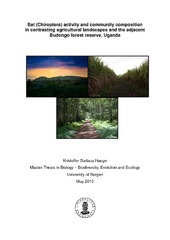Bat (Chiroptera) activity and community composition in contrasting agricultural landscapes and the adjacent Budongo forest reserve, Uganda
Master thesis
Permanent lenke
https://hdl.handle.net/1956/4326Utgivelsesdato
2010-06-01Metadata
Vis full innførselSamlinger
Sammendrag
Abstract. Human activities are causing a biodiversity crisis in all biomes of the Earth. As the world's population continues to grow, more land will be converted to agricultural land to meet the growing food demands, especially in the tropics where we find the most species rich habitats in the world. Many of these species and ecosystems provide valuable services to the humans living here. To best protect species richness and the people dependent on rural livelihoods in the tropics, two types of managed agricultural landscapes have been suggested: land sparing and land sharing. Land sparing promotes high yield agriculture in order to have as large an area as possible protected, while land sharing is farming a more extensive area of the landscape, but is able to retain more species and ecosystem services by using agricultural methods such as agroforestry. The potential for conservation and retaining ecosystem services in a land sharing or a land sparing type landscape in Uganda is addressed using data about insectivorous bats recorded with Anabat detectors in habitats from sugarcane, home garden and forest in and around Budongo forest, Uganda. Species richness, diversity, activity and species composition were determined for all habitats and used to give a picture of the conservation value of the different habitat types. As found in other studies both agricultural landscape types have a higher species richness and diversity than the forest habitat. But the higher activity and number of species related to the forest gives the home garden landscape better potential for conservation of microbats. Scattered trees and distance to the forest in the sugarcane landscape type does not add any conservation value compared to the sugarcane habitat. This study helps to demonstrate the value of land sharing type agriculture for conserving species richness and retaining ecosystem services.
Utgiver
The University of BergenOpphavsrett
The authorCopyright the author. All rights reserved
